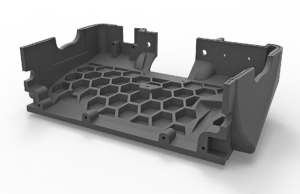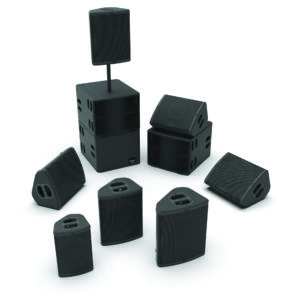#nexosound
#nexolife
Part 5
NEXO waited 30 years to release an injection-moulded cabinet, namely the STM Series modular line array, and, over the last decade, the company has switched between wooden and injection-moulded polyurethane enclosures. Joseph Carcopino, Director of R&D, lifts the lid on the tension between technological possibilities and industrial techniques, and how balancing the two affects the creative design process.
“The body of work that is our intellectual property (acoustic and mechanical patents, for example) is continuously growing. But the implementation of these theoretical ideas (with the physical components) is also an ever-changing landscape.
“Back in the 90s, we used a manual moulding technique for the large polyester parts in our Alpha System, then injected polyurethane techniques for our GEO System waveguide and high-pressure injection for the P+ Series horn, so you can see that we choose different techniques each time to serve the idea of sound wave shaping. And this of course continues to evolve. Today, continuous carbon fibre or copper 3D printing opens new horizons because it allows us to get rid of the constraints of the moulding techniques (the part has to be removable from the mould!). This profoundly changes the way we think of parts, because we are free from nearly any building constraints.”

“While we are thinking of what is right for the next generation of products, we also have to consider how best to use our industrial resources. While injection-moulded technological processes were becoming available, we had to transition our factory from the era of Alpha Series.” NEXO duly acquired its own injection-moulding industrial facility, based in Saint Pierre de Côle, near Limoges, which supplies the main factory in Plailly, near Paris.
“For the first models in the GEO Series, the cabinet was mainly wood, and the plastic element was very small. We had to combine our know-how with the need to maximise our factory resources, and to build products that were suitable for the outside environment (wood is not ideal for this), so we moved to the idea of injected cabinets.” The progression of products since 2011 – with the flagship modular line array STM Series, and then the three line array designs GEO M6, M10 and M12 – all use injection-moulded enclosures.
NEXO returned to its wood supplier for its latest P+ Series of point-source cabinets and monitors. Joseph cites a technical and a marketing reason for this design decision. “P+ Series boxes are used in close proximity to musicians, who have a very personal reaction to the stability and solidity of wooden enclosures – they feel expensive, whereas the plastic cabinets feel cheap. The constraints in size and weight for the P+ Series are very different to the GEO M range. We don’t have to install rigging hardware on the cabinet, but, because it needs to be small and lightweight, inside there is not one spare centimetre for honeycomb structures like we can use on the GEO boxes. For this arrangement, using bent wood provided the best solution.”

(Click here to watch a short video on the special processes introduced at NEXO to manufacture the bent wood enclosures.)
“Wood is harder to work with, it’s a natural material so there are tolerances that vary. The comportment of wood with humidity, rain and solar rays makes it weak compared to plastic. We’ve developed some tricks to handle this, such as the special paint we use for the P+ Series which is a kind of plastic, and very resistant to environmental conditions. Techniques for working with wood continue to evolve, different glue, veneer, etc, but as far as cabinets are concerned, there is not much radical innovation. But for the acoustic parts such as the horn or the waveguides, there are many things we can achieve using new techniques such as nanotechnology which will open doors to new acoustic products.”
This discussion brings up yet another NEXO patented device, the V-Shaped Port, which was first developed for the STM M46 and M28 cabinets, and of which a second enhanced iteration can be found in the GEO M10 and M12 modules. Vented enclosures are used to extend low frequency response. At cabinet tuning frequency, the entire acoustic energy is radiated by the vent. However, a conventional vent also radiates higher order harmonics which are detrimental to on-axis frequency response and directivity consistency. Creating a slot in the vent, the depth and shape of which has been carefully modelled, allows these harmonics to be absorbed.
“Probably we could not have manufactured the shape of the port with a standard wood process. But when you are manufacturing in plastic, a very simple port will cost the same as a complex v-shaped port. Because of this, we can apply our expertise and know-how to achieve better performance without loading extra cost onto the product.”
“As well as innovating manufacturing techniques, we also have to get rid of an important limitation which is our brain! Even if the skill and intuition of an experienced engineer is the most valuable input to a system design, our problem-solving is limited by the mathematical, logical or scientific approaches. We need square, circles, hexagons or other regular shapes to solve our mechanical criteria. But if we ask the computer to compute the best solution (for example, optimized strengthening to remove unwanted vibration in a mechanical part, such as a speaker cone) based on boundary element techniques, you would be surprised by the “organic” nature of the computer’s solution. These kind of solutions are not thinkable by human brains, and it is funny to observe that by “simulating nature”, a computer can give birth to such organic shapes.”
















































